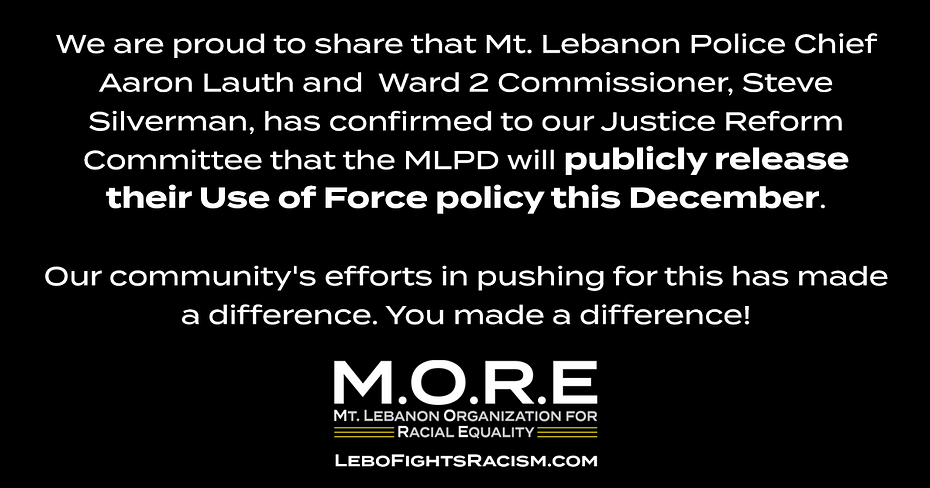Public trust in police departments has undeniably eroded across America, and rightfully so as the Black Lives Matter movement sheds light on racially biased injustices. The people have a right to know what force a public servant can use on them—on us. Since we, the Mt. Lebanon Organization for Racial Equality (M.O.R.E), was established in June 2020, our first goal was for the Mt. Lebanon Police Department (MLPD) to release their Use of Force policy to the public in the name of transparency, following the trend set by the City of Pittsburgh, Allentown, and Bethlehem.
We are proud to share that Mt. Lebanon Police Chief Aaron Lauth and Mt. Lebanon’s Ward 2 Commissioner, Steve Silverman, has confirmed to our Justice Reform Committee that the MLPD will publicly release their Use of Force policy this December. Our community’s efforts in pushing for this has made a difference. You made a difference!
On the MLPD’s website, and recently in the Mt. Lebanon Magazine’s September edition, a summary of their Use of Force policy was provided. Like most national advocacy groups in this arena, M.O.R.E believes a policy summary is not sufficiently transparent. To foster trust around force issues, the actual policy needs to be public and before a policy is adopted, the public should have the ability to weigh in on the policy. In Carl Jung’s words, “you are what you do, not what you say you’ll do”. Only having a summary requires the public to trust their word, and we are in a time where the public simply can’t. Even when the policy is publicly released, this is only the beginning. We want policies that protect our civil rights, but more importantly, that it’s enforceable and officers that don’t follow these policies are held accountable with the appropriate consequences.
“You are what you do, not what you say you’ll do”
Carl Gustav Jung, Psychiatrist and Psychoanalyst
Here is the Mt. Lebanon’s Police Department’s summary of their Use of Force policy with annotations by M.O.R.E regarding some of our concerns that are not addressed by this summary—what could be problematic and where we’re looking for more transparency within the final Use of Force document (italicized formatting has been added to draw attention):
- Prohibits chokeholds and other maneuvers that may lead to positional asphyxiation, unless deadly force is warranted.
- We are expected to trust our officers to determine when deadly force is warranted, and we want to know what factors in that decision.
- We’d also like to see that chokehold are prohibited without exceptions for certain demographics including, but not limited to, pregnant persons, frail elderly, and those with certain medical needs and/or conditions.
- Requires de-escalation throughout as an alternative to force being used.
- What do these de-escalation tactics look like?
- How much de-escalation training do new officers receive and how much refresher/maintenance training do exist and veteran officers receive yearly?
- Does the training use proven andragogical techniques and experiential training methods (role-plays, simulations, desktop exercises, forum theatre, etc.)?
- Requires warning before shooting if possible [per TENNESSEE v. GARNER, 471 U.S. 1 (1985)].
- What is the warning? Is it spoken only? What is the protocol if the subject is hard of hearing, deaf, or has a neurological condition that prevents them from hearing/processing a spoken warning?
- How much time after the warning must pass before the officer can shoot?
- In what situations is a warning not possible?
- Requires that force used must be “objectively reasonable” based on the facts and circumstances confronting the officer(s) and judged from the perspective of a reasonable officer on the scene [per GRAHAM v. CONNOR 490 U.S. 386 (1989)].
- What is the MLPD’s definition of “objectively reasonable”?
- What is a “reasonable” officer? What happens when there is no “reasonable” officer on the scene? How can we be guaranteed there will always be a “reasonable” officer?
- Beyond the judgement from the other “reasonable” officers on the scene, what other methods are you using to hold the officers accountable during an incident where force may be used?
- If the judgement from a reasonable officer on the scene determines that the use of force they witnessed was not objectively reasonable, what they can do to intervene to protect the civilian?
- Requires duty to intervene if unreasonable force is observed. (This applies to other Mt. Lebanon police officers.)
- What exactly applies to other Mt. Lebanon police officers? Their responsibility to intervene or their responsibility to observe?
- What can the other officers specifically do to intervene? Is their primary goal to protect the civilian or their fellow officers?
- How are they expected to handle situations in which they witness excessive use of force without escalating the situation?
- What can civilians do if/when we witness objectively excessive use of force and the other “reasonable” officer on the scene does not agree, or there is no other “reasonable” officer on the scene?
- Bans shooting at moving vehicles, unless deadly force is warranted.
- We’d like to know what factors into the officers’ decision for determining when deadly force is warranted.
- We’d also like to see that shooting at moving vehicles is banned without exception when a person belonging to a specific demographic is suspect to be in the targeted vehicle including, but not limited to minors, pregnant persons, frail elderly, and those with certain medical needs and/or conditions.
- Lists force options which are examples of force tactics and techniques available to police officers when force is used against a subject. Officers should use an appropriate force option based on subject behavior.
- We the people have a right to know what you can do to us. You know what we can do to you. We want to see this list of options spelt out in addition to when it is considered “appropriate” to be used in response to the subject’s behavior.
- Are these force options part of a force continuum or does the MLPD not subscribe to a force continuum concept? Why or why not?
- Requires comprehensive reporting, specifically the use of a separate Use of Force reporting form and supervisory review.
- Who performs the supervisory review and how can we be assured they aren’t biased?
- What happens if this review determines that the use of force was not appropriate?
- What are the consequences of not following these policies? Who determines what the consequences are and if they are “appropriate” or of equal proportion?
- Will the separate Use of Force reporting form be publicly released as well?
These are just some of the questions and concerned we are hoping to see answered when the Mt. Lebanon Police Department publicly releases their full Use of Force document in December. The MLPD calls this their “most critical document” and claims that it “consistently recognizes the value, sanctity, and preservation of human life.” We want to believe them when they say they have the most progressive Use of Force and de-escalation policies that combat systemic racism and prevents implicit bias, but the community simply can’t take them at their word anymore. We need to see these policies, and more importantly, see that the officers of the MLPD follow them. This is just the beginning of the long road to rebuild trust between our community and our police department.
“If you have nothing to hide, you have nothing to fear.”
Origins of the quote are unclear, but it’s been used by a number of people in a number of places in the name of transparency: Richard Graham, Conservative Member of Parliament (MP) for Gloucester, UK, in defense of mass government surveillance; Joseph Goebbels, Nazi Minister of Public Enlightenment and Propaganda; George Orwell’s novel, “1984”
Sources
- Mt. Lebanon Police Department, “Learn About the Mt. Lebanon Police Department” (Jun. 26, 2020). Mt.LebanonPD.org.
- “Police Seeking Residents’ Views” (Aug. 25, 2020). Mt. Lebanon Magazine.
- Rehnquist, William H, and Supreme Court Of The United States. “U.S. Reports: Graham v. Connor et al., 490 U.S. 386.” (1988). Library of Congress.
- White, Byron Raymond, and Supreme Court Of The United States. “U.S. Reports: Tennessee v. Garner, 471 U.S. 1.” (1984). Library of Congress.

